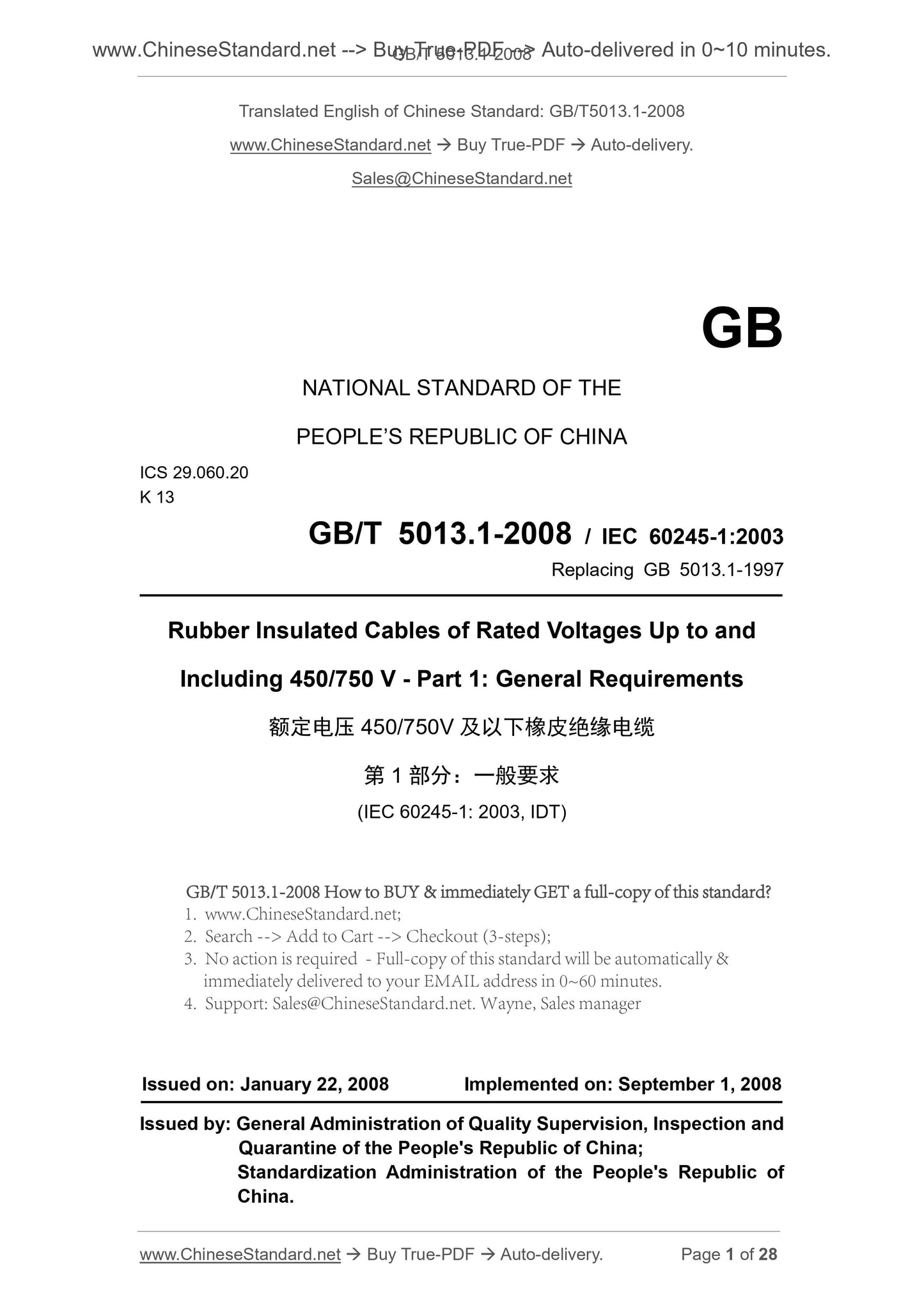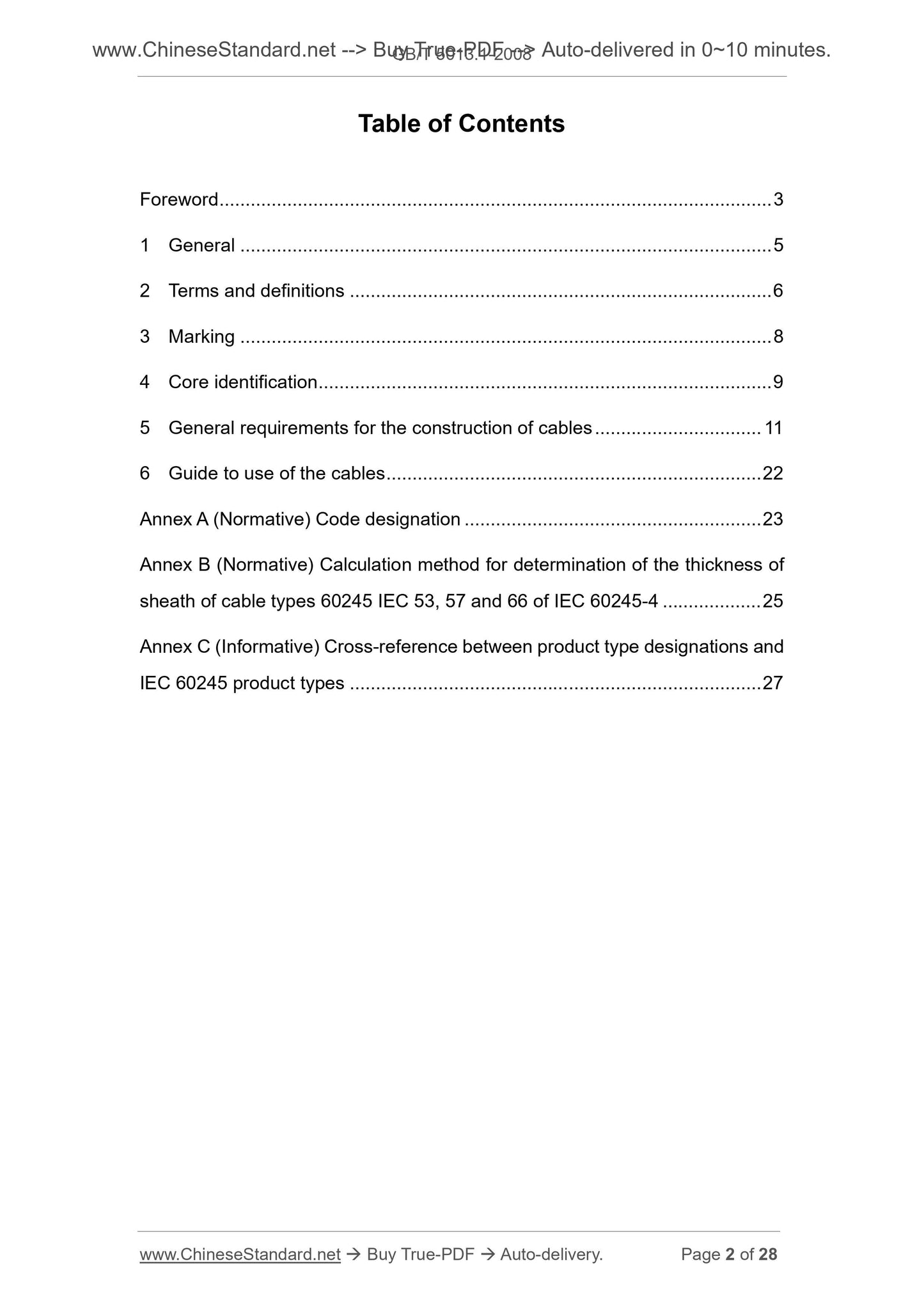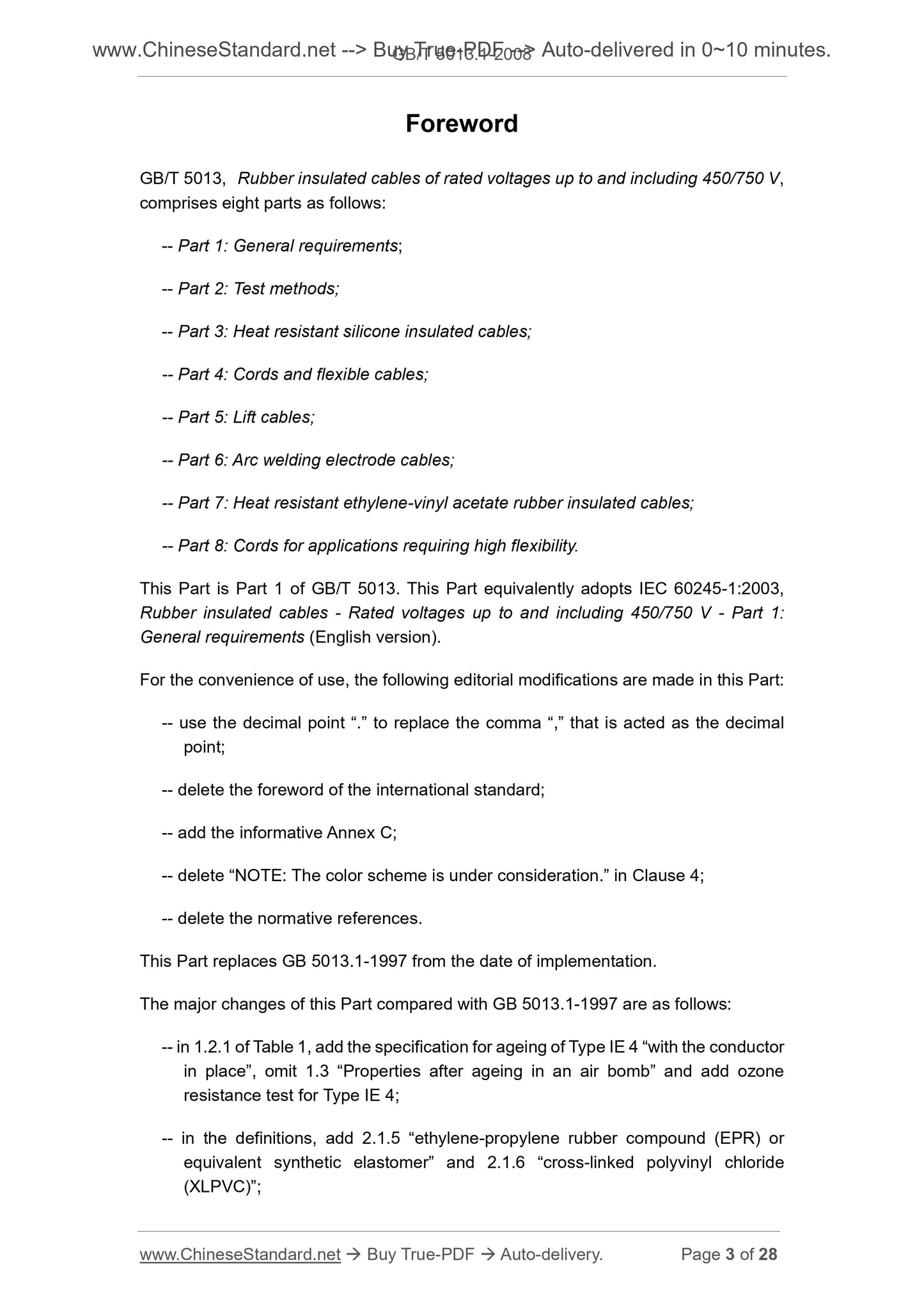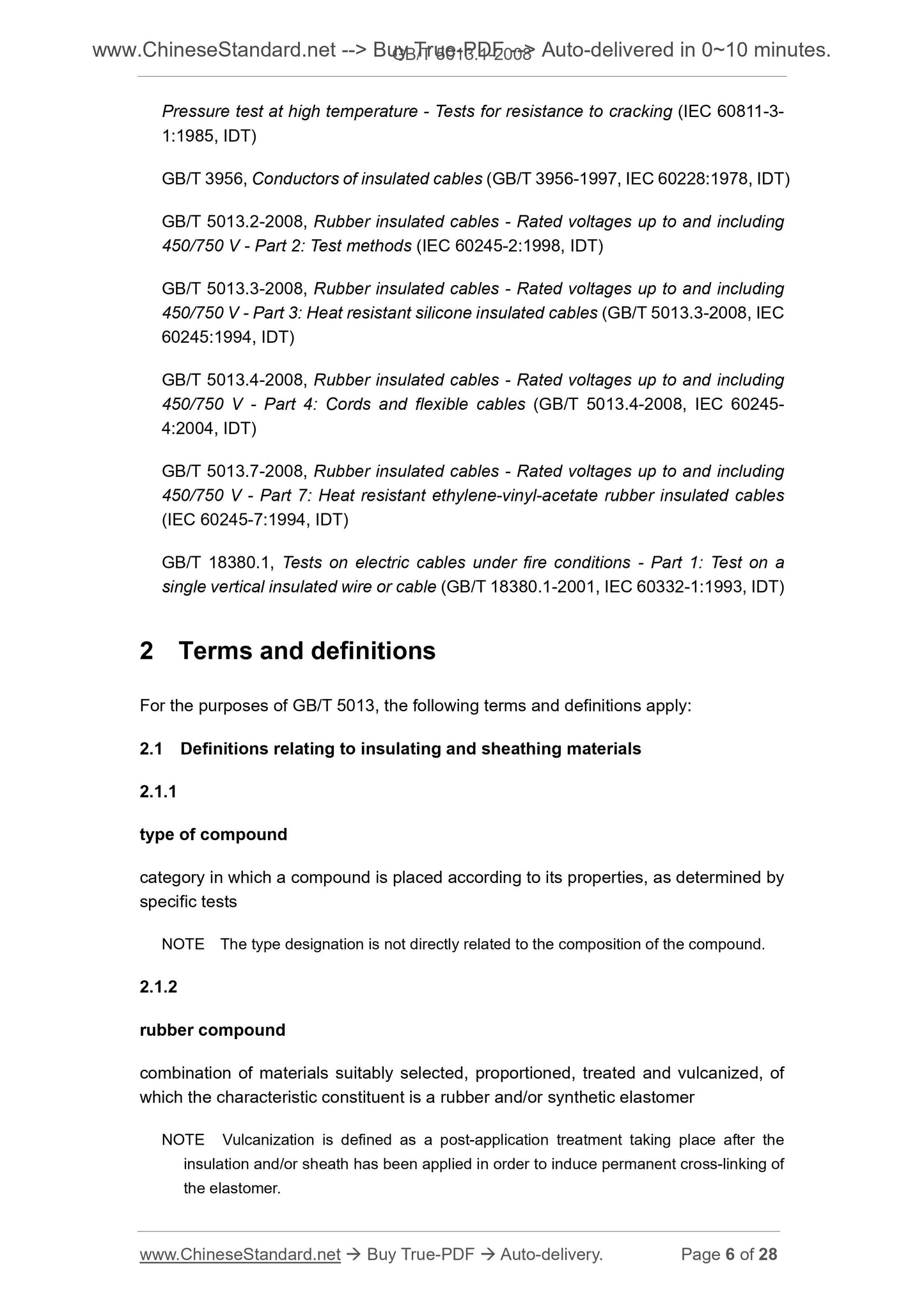1
/
of
6
www.ChineseStandard.us -- Field Test Asia Pte. Ltd.
GB/T 5013.1-2008 English PDF (GB/T5013.1-2008)
GB/T 5013.1-2008 English PDF (GB/T5013.1-2008)
Regular price
$85.00
Regular price
Sale price
$85.00
Unit price
/
per
Shipping calculated at checkout.
Couldn't load pickup availability
GB/T 5013.1-2008: Rubber insulated cables of rated voltages up to and including 450/750 V -- Part 1: General requirements
Delivery: 9 seconds. Download (and Email) true-PDF + Invoice.Get Quotation: Click GB/T 5013.1-2008 (Self-service in 1-minute)
Newer / historical versions: GB/T 5013.1-2008
Preview True-PDF
Scope
1.1 ScopeGB/T 5013 This section applies to the rated voltage U0/U 450/750V and below, vulcanized rubber insulation and sheath (if any)
Hard and soft cables for the exchange of rated voltage not exceeding 450/750V power plant.
NOTE. The term "flexible cord" is used for some models of flexible cables.
Various types of cables in GB/T 5013.3, GB/T 5013.4 and other parts of the provisions of the cable model representation in Appendix A.
GB/T 5013 Test methods specified in parts 1 to 8 see GB/T 5013.2, GB/T 18380.1 and GB/T 2951
Related parts.
1.2 Normative references
The following documents contain provisions which, through reference in this part of GB/T 5013, become the provisions of this section. Any reference to the date of the citation
All subsequent amendments (not including errata content) or revisions do not apply to this section, however, encouraged to be reached under this section
The parties to the agreement study whether the latest versions of these documents are available. For undated references, the latest version applies to this book
section.
GB/T 2951.1-1997 Common test methods for cable insulation and sheathing materials - Part 1. Common test methods Section 1. Thickness
Measurement of dimensions and dimensions --- Mechanical test (idt IEC 60811-1-1..1993)
GB/T 2951.2-1997 Common test methods for insulating and sheathing materials of cables Part 1. Common test methods Section 2. Heat
Aging test method (idt IEC 60811-1-2. 1985)
GB/T 2951.4-1997 Common test methods for cable insulation and sheathing materials - Part 1. Common test methods Section 4. Low
Temperature test method (idt IEC 60811-1-4. 1985)
GB/T 2951.5-1997 Common test methods for insulating and sheathing materials of cables - Part 2. Special test methods for elastomeric compounds
Method 1. Ozone resistance test --- Thermal elongation test --- Immersed mineral oil test (idt IEC 60811-2-1. 1986)
GB/T 2951.6-1997 General test methods for insulating and sheathing materials of cables - Part 3. Specific tests for PVC compounds
Methods Section 1. High Temperature Pressure Test --- Cracking Resistance Test (IEC 60811-3-1. 1985, IDT)
GB/T 3956 cable conductor (GB/T 3956-1997, idt IEC 60228. 1978)
GB/T 5013.2-2008 Rubber insulated cables of rated voltages up to and including 450/750V - Part 2. Test methods (IEC 60245-2.
1998, IDT)
GB/T 5013.3 Rated voltage 450/750V and below rubber insulated cables - Part 3. Heat-resistant silicone rubber insulated cables
(GB/T 5013.3-2008, IEC 60245-3..1994, IDT)
GB/T 5013.4 Rated voltage 450/750 V and below rubber insulated cables - Part 4. Cords and flexible cables
(GB/T 5013.4-2008, IEC 60245-4..2004, IDT)
GB/T 5013.7-2008 Rated voltage 450/750V and below rubber insulated cables - Part 7. Heat-resistant ethylene - vinyl acetate
Ester rubber insulated cable (IEC 60245-7..1994, IDT)
GB/T 18380.1 burning test of cables under fire conditions - Part 1. Vertical burning test of single insulated wire or cable
Methods (GB/T 18380.1-2001, IEC 60332-1..1993, IDT)
Basic Data
| Standard ID | GB/T 5013.1-2008 (GB/T5013.1-2008) |
| Description (Translated English) | Rubber insulated cables of rated voltages up to and including 450/750 V -- Part 1: General requirements |
| Sector / Industry | National Standard (Recommended) |
| Classification of Chinese Standard | K13 |
| Classification of International Standard | 29.060.20 |
| Word Count Estimation | 19,140 |
| Date of Issue | 2008-01-22 |
| Date of Implementation | 2008-09-01 |
| Older Standard (superseded by this standard) | GB 5013.1-1997 |
| Quoted Standard | GB/T 2951.1-1997; GB/T 2951.2-1997; GB/T 2951.4-1997; GB/T 2951.5-1997; GB/T 2951.6-1997; GB/T 3956; GB/T 5013.2-2008; GB/T 5013.3; GB/T 5013.4; GB/T 5013.7-2008; GB/T 18380.1 |
| Adopted Standard | IEC 60245-1-2003, IDT |
| Regulation (derived from) | Announcement of Newly Approved National Standards No. 2, 2008 (No. 115 overall) |
| Issuing agency(ies) | General Administration of Quality Supervision, Inspection and Quarantine of the People's Republic of China, Standardization Administration of the People's Republic of China |
| Summary | This standard applies to the rated voltage Uo/U is 450/750V and below, vulcanized rubber insulated and sheathed (if any) of the hard and soft cable for 450/750V AC rated voltage does not exceed the power unit. Various types of cables in GB/T 5013. 3, GB/T 5013. 4 and other parts stipulates that cable type notation see Appendix A. |
Share











